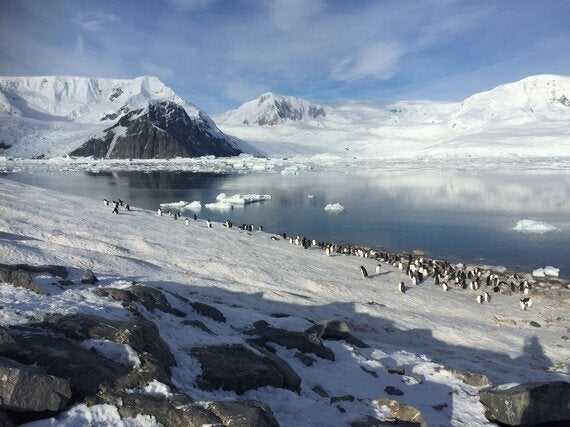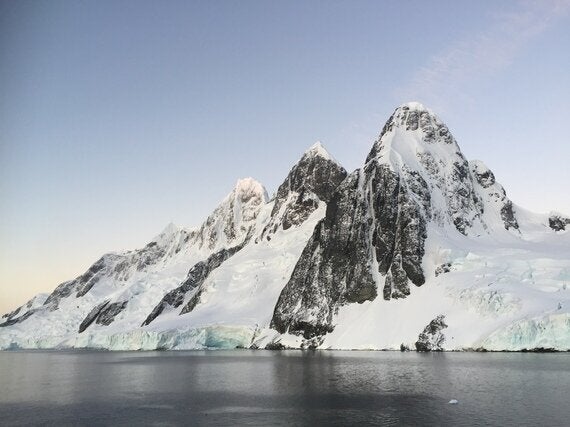Nowhere compares to Antarctica for observing nature at its most elemental. While the journey today is a far cry from the treacherous, ice-thwarted voyages once faced by 16th-century navigators, an expedition cruise still has a touch of the intrepid. Go at the tail end of summer and you'll be in for a wildlife treat.

Drake Shake
I'd been warned about the dreaded Drake, the passage which once filled early explorers with foreboding. Reaching 600 miles from the tip of South America to the South Shetland Islands, this strait is the world's roughest stretch of water. So as I boarded the One Ocean Akademik Ioffe, a former Russian research vessel, for a 10-night Marine Mammals Voyage, I dosed up on seasickness medication and braced myself for the worst. As every polar veteran will tell you, you have to earn Antarctica - two days of choppy seas is the price you pay. If you're lucky, you get the super-smooth 'Drake Lake', but otherwise it's the 'Drake Shake'. As we left the Beagle Channel behind and entered open waters, high winds and gales began to rock the ship relentlessly from side to side. We'd notched 9 on the Beaufort Scale and things were beginning to slide - furniture, crockery, people. The portholes showed steel-grey ocean and sky on repeat.
Drake days were divided between lectures with the onboard team of experts on everything from whale tagging to penguin particularities, and time spent on the upper deck, gazing out to sea and watching wandering albatrosses master the wind. Maps up in the library gave a taste of what was to come. Delusion Pont, Cape Disappointment and Exasperation Inlet - the early navigators sure didn't have it easy.

Arrival in Antarctica
No matter how often you've cooed over March of the Penguins or David Attenborough's Frozen Planet, nothing prepares you for the reality of Antarctica. The Drake had seemed to suck all colour out of the world, but Antarctica shone. As if on cue, we arrived to dazzling sunshine in Fournier Bay, rimmed by sheer-sided mountains.
Donning wetskins, we hopped onto a Zodiac boat to take a better look, sidling up close to fur seals dozing on icebergs and some 30 humpbacks breaching, blowing and lobtailing. A welcome party of 1,500 gentoo penguins greeted us on nearby Cuverville Island - the biggest rookery of its kind in Antarctica. I'd never imagined we would get this close, see so many. Graceful in water, clumsy on land, the gentoos went about their usual business of waddling across the bay, dodging hungry leopard seals. One particularly plucky penguin even took a fancy to my gumboots.

Marine Mammals
Could it get any better? Apparently so. Day after crystal-clear day, the wildlife pulled out all the stops for us, as we weaved in and out of small bays and channels indenting the Antarctic Peninsula. Penguins porpoised through the Lemaire Channel, nicknamed 'Kodak Gap', with its glassy waters and backdrop of razor-sharp mountains. Icebergs in every fathomable shade of blue rose up like the ruins of a fortified city around Pléneau Island - some turreted, some arched, some as big as castles. In Neko Harbour, where we touched the continent proper, we literally held our breath as an immense glacier calved, creating a wave that sent the resident gentoos skittering across the bay like bowling pins.
Wilhelmina Bay held us captive for hours watching humpbacks feeding, resting and playing, some just a hair's breadth from the Zodiacs. They were close enough for us to admire their individual fluke prints and hear the whoosh as they blew - like the echoing gurgle of a thousand snorkels being cleared at once.
On the final day in Antarctica, we sailed through the narrow Neptune's Bellows passage into the caldera of an active volcano to reach Whalers Bay on Deception Island, where fuel tanks and workshops provided a rusty reminder of a once-thriving whaling industry. Nowadays penguins and lolloping seals guard the ash-coloured beach. But we weren't just there to enjoy the nature. The ultimate Antarctica challenge is the Polar Plunge - the chance to strip down to bathers for a frantic dip in 2°C waters. After wavering initially, I made the mad dash into the heart-stoppingly cold sea.
As day faded and the sun dipped below the horizon like a ripe peach, I took one last lingering look at Antarctica from the snow-frosted bay of Half Moon Island. Chinstrap penguins hopped from rock to rock with ease. Seals barked and gave chase to anyone who ventured too close. We were the outsiders here. I pondered how to sum up my trip and decided that 'once in a lifetime' didn't quite cut it, as frankly I'd go back in a heartbeat.

Need to know
Prices start from £4,850 per person based on triple share, £6,300 for twin share and £7,850 to £8,500 for suite accommodation on the One Ocean Expeditions 10-night Marine Mammals Voyage. Rates includes all meals, excursions, ship transfers, waterproof clothing and onboard lectures. The next voyage is in March 2016, but other expeditions run from November to March. Swoop Antarctica were brilliant in helping me to organise the logistics, helping me to choose my itinerary and coordinate my flights and travel arrangements.